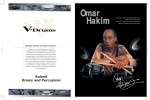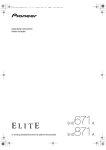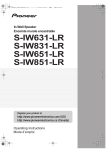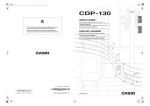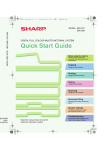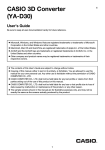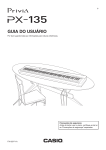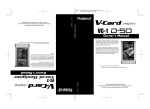Download Casio CDP-120 User`s guide
Transcript
USER’S GUIDE English ES Safety Precautions Before trying to use the Digital Piano, be sure to read the separate “Safety Precautions”. GUÍA DEL USUARIO Guarde toda la información para futuras consultas. Precauciones de seguridad Antes de intentar usar el piano digital, asegúrese de leer las “Precauciones de seguridad” separadas. CDP120-ES-1A Español Please keep all information for future reference. TO REDUCE THE RISK OF FIRE OR ELECTRIC SHOCK, REFER SERVICING TO QUALIFIED SERVICE PERSONNEL. IMPORTANT SAFETY INSTRUCTIONS 1. 2. 3. 4. 5. 6. 7. 8. Read these instructions. Keep these instructions. Heed all warnings. Follow all instructions. Do not use this apparatus near water. Clean only with dry cloth. Do not block any ventilation openings. Install in accordance with the manufacturer’s instructions. Do not install near any heat sources such as radiators, heat registers, stoves, or other apparatus (including amplifiers) that produce heat. 9. Do not defeat the safety purpose of the polarized or grounding-type plug. A polarized plug has two blades with one wider than the other. A grounding type plug has two blades and a third grounding prong. The wide blade or the third prong are provided for your safety. If the provided plug does not fit into your outlet, consult an electrician for replacement of the obsolete outlet. 10.Protect the power cord from being walked on or pinched particularly at plugs, convenience receptacles, and the point where they exit from the apparatus. 11.Only use attachments/accessories specified by the manufacturer. 12.Use only with the cart, stand, tripod, bracket, or table specified by the manufacturer, or sold with the apparatus. When a cart is used, use caution when moving the cart/apparatus combination to avoid injury from tip-over. 13.Unplug this apparatus during lightning storms or when unused for long periods of time. 14.Refer all servicing to qualified service personnel. Servicing is required when the apparatus has been damaged in any way, such as power-supply cord or plug is damaged, liquid has been spilled or objects have fallen into the apparatus, the apparatus has been exposed to rain or moisture, does not operate normally, or has been dropped. The apparatus shall not be exposed to dripping or splashing and that no objects filled with liquids, such as vases, shall be placed on the apparatus. The power indicator being unlit does not mean the apparatus is completely disconnected from the MAINS. When you need to have the apparatus completely disconnected from the MAINS, you must unplug the power cord. For that purpose, locate the apparatus in a way that secures easy access to the power cord. Declaration of Conformity Model Number: CDP-120 Trade Name: CASIO COMPUTER CO., LTD. Responsible party: CASIO AMERICA, INC. Address: 570 MT. PLEASANT AVENUE, DOVER, NEW JERSEY 07801 Telephone number: 973-361-5400 This device complies with Part 15 of the FCC Rules, Operation is subject to the following two conditions: (1) This device may not cause harmful interference, and (2) this device must accept any interference received, including interference that may cause undesired operation. NOTICE This equipment has been tested and found to comply with the limits for a Class B digital device, pursuant to Part 15 of the FCC Rules. These limits are designed to provide reasonable protection against harmful interference in a residential installation. This equipment generates, uses and can radiate radio frequency energy and, if not installed and used in accordance with the instructions, may cause harmful interference to radio communications. However, there is no guarantee that interference will not occur in a particular installation. If this equipment does cause harmful interference to radio or television reception, which can be determined by turning the equipment off and on, the user is encouraged to try to correct the interference by one or more of the following measures: • Reorient or relocate the receiving antenna. • Increase the separation between the equipment and receiver. • Connect the equipment into an outlet on a circuit different from that to which the receiver is connected. • Consult the dealer or an experienced radio/TV technician for help. FCC WARNING Changes or modifications not expressly approved by the party responsible for compliance could void the user’s authority to operate the equipment. CDP120_e.book 1 ページ 2011年4月20日 水曜日 午後12時55分 Important! • Before using the AD-A12150LW Adaptor to power the product, be sure to check the AC Adaptor for any damage first. Carefully check the power cord for breakage, cuts, exposed wire and other serious damage. Never let children use an AC adaptor that is seriously damaged. • The product is not intended for children under 3 years. • Use only CASIO AD-A12150LW adaptor. • The AC adaptor is not a toy. • Be sure to disconnect the AC adaptor before cleaning the product. This mark applies in EU countries only. Manufacturer: CASIO COMPUTER CO.,LTD. 6-2, Hon-machi 1-chome, Shibuya-ku, Tokyo 151-8543, Japan Responsible within the European Union: CASIO EUROPE GmbH Casio-Platz 1, 22848 Norderstedt, Germany ● Any reproduction of the contents of this manual, either in part or its entirety, is prohibited. Except for your own, personal use, any other use of the contents of this manual without the consent of CASIO is prohibited under copyright laws. ● IN NO EVENT SHALL CASIO BE LIABLE FOR ANY DAMAGES WHATSOEVER (INCLUDING, WITHOUT LIMITATION, DAMAGES FOR LOSS OF PROFITS, BUSINESS INTERRUPTION, LOSS OF INFORMATION) ARISING OUT OF THE USE OF OR INABILITY TO USE THIS MANUAL OR PRODUCT, EVEN IF CASIO HAS BEEN ADVISED OF THE POSSIBILITY OF SUCH DAMAGES. ● The contents of this manual are subject to change without notice. ● The actual appearance of the product may be different from that shown in the illustrations in this User’s Guide. ● Company and product names used in this manual may be registered trademarks of others. E-1 English Please note the following important information before using this product. CDP120_e.book 2 ページ 2011年4月20日 水曜日 午後12時55分 Contents General Guide ............................. E-3 Getting Ready to Play ................ E-4 Preparing the Music Stand .................................E-4 Connecting a Pedal Unit.....................................E-4 Power Supply .....................................................E-4 Playing the Digital Piano............ E-5 Turning on Power and Playing ...........................E-5 Using Headphones .............................................E-5 Using a Damper Pedal .......................................E-6 Changing Keyboard Response to Touch Pressure (Touch Response)....................E-6 Select from a variety of musical instrument sounds .................................E-7 Playing Tone Demo Songs.................................E-7 Layering Two Tones ...........................................E-7 Using Reverb......................................................E-7 Using Chorus......................................................E-8 Changing the Pitch (Transpose, Tuning)............E-8 Connecting External Devices .... E-9 Connecting a Computer .....................................E-9 MIDI Settings ....................................................E-10 Outputting Keyboard Notes to Audio Equipment ..............................................E-10 Reference .................................. E-11 Troubleshooting................................................E-11 Specifications ...................................................E-12 Operating Precautions......................................E-13 MIDI Implementation Chart Included Accessories Separately Available Accessories ● Music Stand ● Pedal ● Leaflets • Safety Precautions • Other (Warranty, etc.) Items included as accessories are subject to change without notice. • You can get information about accessories that are separately for this product from the CASIO catalog available from your retailer, and from the CASIO website at the following URL. E-2 http://world.casio.com/ CDP120_e.book 3 ページ 2011年4月20日 水曜日 午後12時55分 English General Guide • In this manual, the term “Digital Piano” refers to the CDP-120. • In this manual, buttons and other controllers are identified using the numbers shown below. 1 2 3 4 5 6 7 8 9 9 ■ Back bk 1 VOLUME knob ☞E-5 2 POWER button ☞E-5 3 DEMO, FUNCTION button ☞E-6, 7 4 GRAND PIANO 1 button ☞E-7 5 GRAND PIANO 2 button ☞E-7 6 ELEC PIANO button ☞E-7 7 HARPSICHORD button ☞E-7 bl bm bn 8 STRINGS button ☞E-7 9 Speakers bk USB port ☞E-9 bl DAMPER PEDAL jack ☞E-4 bm DC 12V terminal ☞E-4 bn PHONES/OUTPUT jack ☞E-5 E-3 CDP120_e.book 4 ページ 2011年4月20日 水曜日 午後12時55分 Getting Ready to Play Preparing the Music Stand Music stand Power Supply Your Digital Piano runs on standard household power. Be sure to turn off power whenever you are not using the Digital Piano. Using the AC Adaptor Use only the AC adaptor (JEITA Standard, with unified polarity plug) that comes with this Digital Piano. Use of a different type of AC adaptor can cause malfunction of the Digital Piano. Specified AC Adaptor: AD-A12150LW Connecting a Pedal Unit • Use the supplied power cord to connect the AC adaptor as shown in the illustration below. Household power outlet AC adaptor DAMPER PEDAL jack DC 12V terminal Power cord Note the following important precautions to avoid damage to the power cord. During Use • Never pull on the cord with excessive force. • Never repeatedly pull on the cord. • Never twist the cord at the base of the plug or connector. During Movement • Before moving the Digital Piano, be sure to unplug the AC adaptor from the power outlet. During Storage • Loop and bundle the power cord, but never wind it around the AC adaptor. • Never connect the AC adaptor (JEITA Standard, with unified polarity plug) that comes with this Digital Piano to any other device besides this Digital Piano. Doing so creates the risk of malfunction. • Make sure the Digital Piano is turned off before plugging in or unplugging the AC adaptor. • The AC adaptor will become warm to the touch after very long use. This is normal and does not indicate malfunction. E-4 CDP120_e.book 5 ページ 2011年4月20日 水曜日 午後12時55分 English Playing the Digital Piano 1 2 Turning on Power and Playing 1. Press 2. This turns on power. • To turn off the Digital Piano, press 2 again. 2. Try playing something on the keyboard. Use 1 3 4 5 6 7 8 Using Headphones Using headphones cuts off output from the built-in speakers, which means you can practice playing even late at night without disturbing others. • Be sure to turn down the volume level before connecting headphones. to adjust volume. PHONES/OUTPUT jack • Turning off the Digital Piano causes most current settings to be cleared. The Digital Piano will revert to initial settings the next time you turn it on. Once you turn it on it remains on until you turn it off again. Auto Power Off If you do not perform any operation for 30 minutes, the Digital Piano will turn off automatically. ■ Disabling Auto Power Off • Headphones do not come with the Digital Piano. • Use commercially available headphones. See page E-2 for information about options. • Do not listen to very high volume output over headphones for long period. Doing so creates the risk of hearing damage. • If you are using headphones that require an adaptor plug, make sure you do not leave the adaptor plugged in when removing the headphones. You can disable Auto Power Off to ensure that power is not turned off automatically during a concert, etc. 1. While holding down 8, turn on power. Auto Power Off will be disabled. E-5 CDP120_e.book 6 ページ 2011年4月20日 水曜日 午後12時55分 Playing the Digital Piano Using a Damper Pedal Connecting a pedal to the DAMPER PEDAL jack makes it possible to use the pedal as a damper pedal (page E-4). Pressing the damper pedal while playing will cause the notes you play to reverberate for a very long time. Changing Keyboard Response to Touch Pressure (Touch Response) Changing Touch Response Sensitivity Use the procedure below to control how much the volume of played notes change in accordance with playing speed. Select the setting that best matches your playing style. 1. While holding down 3, press one of the keys in the TOUCH RESPONSE area of the keyboard to specify the Touch Response sensitivity. Touch Response alters tone volume in accordance with keyboard pressure (speed). This provides you some of the same expressivity you get on an acoustic piano. Pressing fast produces louder notes. Pressing slowly produces softer notes. Do not try to use too much pressure. Off (OFF) Touch Response is turned off. Sound volume is fixed, regardless of key press speed. Type1 (1) Normal Touch Response Type2 (2) More sensitive Touch Response than Type 1 Type3 (3) Less sensitive Touch Response than Type 1 • The initial default Touch Sensitivity setting is Type1. E-6 CDP120_e.book 7 ページ 2011年4月20日 水曜日 午後12時55分 Playing the Digital Piano Your Digital Piano lets you select from among five different types of tones. Even the same song sound takes on a different feel by changing the instrument type. To select an instrument for playing 1. Press a button from 4 through 8 that corresponds to the tone you want to select. • The initial default tone setting is GRAND PIANO 1. 2. Try playing something on the keyboard. The tone of the instrument you selected will sound. Layering Two Tones You can use the following procedure to layer two different tones (such as piano and strings) so they sound simultaneously when you press a keyboard key. 1. Simultaneously press two buttons from 4 8 through that correspond to the two tones you want to layer. 2. Play something on the keyboard. Both tones sound at the same time. 3. To unlayer the tones and return the keyboard to a single tone, press any one of the buttons from through . 4 8 Using Reverb Reverb adds reverberation to notes. You can change the duration of the reverb. 1. While holding down 3, press a key within the REVERB area of the keyboard to adjust the reverb length. Playing Tone Demo Songs Your Digital Piano comes with five built-in demo tunes, which demonstrate the characteristics of each of the five tones. Tone Name Tune Name GRAND PIANO 1 Prélude [Suite bergamasque] GRAND PIANO 2 Étude Op.25-9 “Butterflies” ELEC PIANO Original HARPSICHORD Gavotte [Französische Suite 5] STRINGS Nessun Dorma [Turandot] 1. Press 3. This will start playback of the demo songs. • Pressing a tone button ( through ) while demo song playback is in progress will switch to the demo song of that tone. 4 8 2. Press 3 again to stop playback. Playback of the demo songs will continue in an endless loop until you press to stop it. 3 OFF Turns off reverb. 1 to 10 The larger the number selected, the longer the reverb duration. • The initial default reverb setting is 6. E-7 English Select from a variety of musical instrument sounds CDP120_e.book 8 ページ 2011年4月20日 水曜日 午後12時55分 Playing the Digital Piano Using Chorus Chorus is a function that adds depth and breadth to notes. It makes you sound as if you are playing multiple instruments. 1. While holding down 3, press a key within the CHORUS area of the keyboard to select a chorus type. There are five chorus types, plus an off setting. • The actual effect produced by chorus depends on the tone you are using. The initial default chorus setting is OFF. Changing the Pitch (Transpose, Tuning) Changing the Pitch in Semitone Steps (Transpose) The transpose feature lets you change the pitch, in semitone steps. A simple operation lets you instantly change the pitch to match that of a singer. • The transpose setting range is –12 to +12 semitones. The initial default transpose setting is 0. E-8 1. While holding down 3, press the minus (–) or plus (+) key within the TRANSPOSE area of the keyboard to change the setting. • Each press of a key increases or decreases the current setting by 1. • To return to the initial default setting, press the minus (–) and plus (+) keys at the same time. Fine Tuning (Tuning) Use the tuning feature when you need to adjust the pitch slightly to play along with another musical instrument. Also, some artists perform their music with slightly altered tuning. You can use the tuning feature to adjust tuning so it exactly matches a performance on a CD. • The tuning feature specifies the frequency of the A4 note. You can set a frequency within the range of 415.5 to 465.9 Hz. The initial default setting is 440.0 Hz. 1. While holding down 3, press the minus (–) or plus (+) key within the TUNE area of the keyboard to change the tuning. • Each press of a key increases or decreases the current setting by 0.1 Hz. • To return to the initial default setting (440.0 Hz), press the minus (–) and plus (+) keys at the same time. CDP120_e.book 9 ページ 2011年4月20日 水曜日 午後12時55分 English Connecting External Devices 3 Connecting a Computer You can connect the Digital Piano to a computer and exchange MIDI data between them. You can send play data from the Digital Piano to music software running on your computer, or you can send MIDI data from your computer to the Digital Piano for playback. Minimum Computer System Requirements The following shows the minimum computer system requirements for sending and receiving MIDI data. Check to make sure that your computer complies with these requirements before connecting the Digital Piano to it. • Operating System Windows® XP (SP2 or later) *1 Windows Vista® *2 Windows® 7 *3 Mac OS® X (10.3.9, 10.4.11, 10.5.8 or later, 10.6.6 or later) *1: Windows XP Home Edition Windows XP Professional (32-bit) *2: Windows Vista (32-bit) *3: Windows 7 (32-bit, 64-bit) Connecting the Digital Piano to Your Computer • Make sure you follow the steps of the procedure below exactly. Connecting incorrectly can make data send and receive impossible. 1. Turn off the Digital Piano and then start up your computer. • Do not start up the music software on your computer yet! 2. After starting up your computer, use a commercially available USB cable to connect it to the Digital Piano. B connector USB cable (A-B type) Digital Piano USB port A connector • USB port Computer USB port • Never connect to a computer that does not conform to the above requirements. Doing so can cause problems with your computer. 3. Turn on the Digital Piano. • If this is the first time you are connecting the Digital Piano to your computer, the driver software required to send and receive data will be installed on your computer automatically. 4. Start up your computer’s music software. E-9 CDP120_e.book 10 ページ 2011年4月20日 水曜日 午後12時55分 Connecting External Devices 5. Configure the music software settings to select one of the following as the MIDI device. CASIO USB-MIDI : (For Windows 7, Windows Vista, Mac OS X) USB Audio Device : (For Windows XP) • For information about how to select the MIDI device, see the user documentation that comes with the music software you are using. • Be sure to turn on the Digital Piano first before starting up your computer’s music software. Local Control There are times when exchanging data with a computer when you may not want the Digital Piano to sound notes you play on its keyboard. The local control setting lets you do just that. 1. While holding down 3, press a key within the LOCAL area of the keyboard to change the local control setting. • The initial default local control setting is ON. Selecting OFF for this setting disables output from the Digital Piano’s speakers. • Once you are able to connect successfully, there is no problem with leaving the USB cable connected when you turn off your computer and/or Digital Piano. • This Digital Piano conforms to General MIDI Level 1 (GM). • For detailed specifications and connections that apply to MIDI data send and receive by this Digital Piano, see the latest support information provided by the website at the following URL. http://world.casio.com/ MIDI Settings Keyboard Channel A keyboard channel is the channel used for sending Digital Piano data to a computer. You can select the channel you want for sending Digital Piano data to a computer. • The keyboard channel setting range is 01 to 16. The initial default keyboard channel setting is 01. 1. While holding down 3, press the minus (–) or plus (+) key within the KEYBOARD CH area of the keyboard to change the keyboard channel. • Each press of a key increases or decreases the current setting by 1. • To return to the initial default setting (01), press the minus (–) and plus (+) keys at the same time. Outputting Keyboard Notes to Audio Equipment Connection requires commercially available connecting cords, supplied by you. The connecting cords should have a stereo standard plug on one end and a plug that matches the configuration of the external device on the other end. • Turn off the external device when making connections. After connecting, turn down the Digital Piano and external device volume levels whenever turning power on or off. • After connecting, turn on the Digital Piano and then the external device. • If keyboard notes sound distorted when they are sounded from external audio equipment, lower the Digital Piano’s volume setting. Stereo standard plug Audio equipment, amplifier, etc. Digital Piano PHONES/OUTPUT jack E-10 CDP120_e.book 11 ページ 2011年4月20日 水曜日 午後12時55分 English Reference Troubleshooting Symptom Action Included Accessories I can’t find something that should be here. Carefully check inside all of the packing materials. Power Requirements Power will not turned on. Correctly attach the AC adaptor (page E-4). Sound Nothing happens when I press any keyboard key. Adjust the volume setting (page E-5). Notes keep sounding, without stopping. Turn power off and then back on to initialize all Digital Piano settings (page E-5). Some notes are cut off while they are playing. Notes are cut off whenever the number of notes being sounded exceeds the maximum polyphony value of 48 (24 for some tones). This does not indicate malfunction. The volume or tone setting I made has changed. • Adjust the volume setting (page E-5). • Turn power off and then back on to initialize all Digital Piano settings (page E-5). Output volume does not change even though is change my keyboard touch. • Change the Touch Response setting (page E-6). • Turn power off and then back on to initialize all Digital Piano settings (page E-5). This is due to system limitations. It does not indicate malfunction. In certain keyboard ranges, the volume and tone quality sound are slightly different from those in other keyboard ranges. With some tones, octaves do not change at the far ends of the keyboard. This is due to system limitations. It does not indicate malfunction. The pitch of the notes does not match other accompanying instruments or sounds strange when played long with other instruments. • Check and adjust the transpose (page E-8) and tuning settings (page E-8). • Turn power off and then back on to initialize all Digital Piano settings (page E-5). The reverb of notes seems to change suddenly. • Check and adjust the reverb setting (page E-7). • Turn power off and then back on to initialize all Digital Piano settings (page E-5). Computer Connection I can’t exchange data between the Digital Piano and a computer. • Check to make sure that the USB cable is connected to the Digital Piano and computer, and that the device is selected correctly with your computer’s music software settings (page E-9). • Turn off the Digital Piano and then exit the music software on your computer. Next, turn the Digital Piano back on and then restart the music software on your computer. E-11 CDP120_e.book 12 ページ 2011年4月20日 水曜日 午後12時55分 Reference Specifications Model Keyboard Touch Response Maximum Polyphony CDP-120BK 88-key piano keyboard 3 types, Off 48 notes (24 for certain tones) Tones Built-in Tones 5; with layer Reverb 1 to 10, Off Chorus 1 to 5, Off Demo Songs 5 songs (tone demo songs) Other Functions Transpose ±1 octaves (–12 to +12 semitones) Tuning A4 = 415.5 to 465.9Hz (Initial Default: 440.0Hz) MIDI 16 multi-timbre received, GM Level 1 standard Inputs/Outputs USB port TYPE B Damper Pedal jack Standard jack Phones/Output jack Stereo standard jack Output Impedance: 3Ω, Output Voltage: 1.5V (RMS) MAX Power Jack 12V DC Power Supply AC Adaptor Auto Power Off Speakers Output Power Consumption AD-A12150LW 30 minutes after last key operation, Auto Power Off can be disabled. (12cm × 6cm oval) × 2 8W + 8W 12V = 18W Dimensions 132.2 × 28.6 × 12.9cm (52 1/16 × 11 1/4 × 5 1/16 inch) Weight Approximately 11.4kg (25.1 lbs) • Design and specifications are subject to change without notice. E-12 CDP120_e.book 13 ページ 2011年4月20日 水曜日 午後12時55分 Reference Operating Precautions English Be sure to read and observe the following operating precautions. ■ Location Avoid the following locations for this product. • Areas exposed to direct sunlight and high humidity • Areas subjected to temperature extremes • Near a radio, TV, video deck, or tuner The above devices will not cause malfunction of the product, but interference from the product can cause audio or video interference of a nearby device. ■ User Maintenance • Never use benzine, alcohol, thinner, or other chemical agents to clean the product. • To clean the product or its keyboard, wipe with a soft cloth moistened in a weak solution of water and a mild neutral detergent. Wring all excess moisture from the cloth before wiping. ■ Included and Optional Accessories Use only accessories that are specified for use with this product. Use of unauthorized accessories creates the risk of fire, electric shock, and personal injury. ■ Weld Lines Lines may be visible on the exterior of the product. These are “weld lines” that result from the plastic molding process. They are not cracks or scratches. ■ Musical Instrument Etiquette Always be aware of others around you whenever using this product. Be especially careful when playing late at night to keep the volume at levels that do not disturb others. Other steps you can take when playing late at night are closing the window and using headphones. E-13 Key’s Ch’s After Touch Control Change Pitch Bender Note ON Note OFF Velocity True voice O X O O O X O X 0, 32 1 6, 38 7 10 11 64 66 O X X O 9nH v = 1 - 127 X 9nH v = 0 0 - 127 O O O (MSB only) O O O O O O X O O 9nH v = 1 - 127 X 9nH v = 0, 8nH v =** 0 - 127 0 - 127 *1 Mode 3 X Mode 3 X Default Messages Altered Mode Note Number 1 - 16 1 - 16 1 1 - 16 Recognized Default Changed Transmitted Basic Channel Function MIDI Implementation Chart Hold 1 Sostenuto Bank select Modulation Data entry *2 Volume Pan Expression **:no relation **:sin relación *1:Depends on tone *1:Depende del tono Remarks Version : 1.0 14 ページ Model: CDP-120 CDP120_s.book 2011年4月20日 水曜日 午後12時52分 Mode 2 : OMNI ON, MONO Mode 4 : OMNI OFF, MONO Aux Messages O O X O O X Mode 1 : OMNI ON, POLY Mode 3 : OMNI OFF, POLY X O X O X X : All sound off : Reset all controller : Local ON/OFF : All notes OFF : Active Sense : Reset X X *2 *2:For details, see MIDI Implementation at http://world.casio.com/. *2:Si desea más información, vea Implementación MIDI en http://world.casio.com/. O O : Clock : Commands System Real Time X X X O Hold 1 Sostenuto Soft pedal Reverb send Chorus send RPN LSB, MSB *2 Remarks X X X : Song Pos : Song Sel : Tune System Common O 0 - 127 O O :True # O O O O O O O X X X O X System Exclusive Program Change 64 66 67 91 93 100, 101 O : Yes X : No This recycle mark indicates that the packaging conforms to the environmental protection legislation in Germany. Esta marca de reciclaje indica que el empaquetado se ajusta a la legislación de protección ambiental en Alemania. C E-18 MA1104-A Printed in China CDP120-ES-1A




















